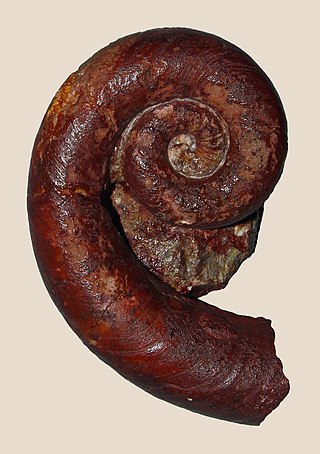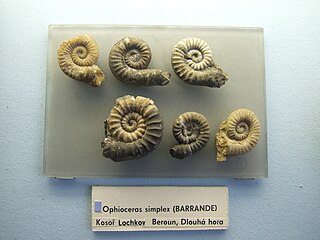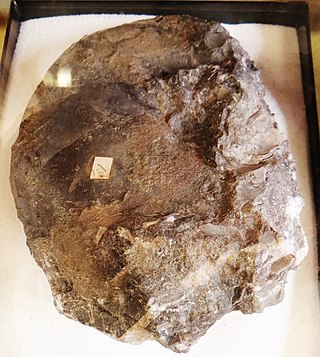
Lituites is an extinct nautiloid genus from the Middle Ordovician and type for the Lituitidae that in some more recent taxonomies has been classified with the orthocerids and listed under the order Lituitida. Fossils have been found in New York, Argentina, Norway, Sweden, Estonia, and China.

Trocholites is a tarphycerid genus in the family Trocholitidae from the Middle and Late Ordovician with a gradually expanding, weakly ribbed shell; whorls in contact, dorsum slightly impressed; cross section depressed, venter and sides rounded; siphuncle close to but not at the dorsal margin.
Armenoceras is a genus of actinocerid nautiloid cephalopods whose fossils ranged from the late Whiterockian Stage in the early Middle Ordovician, through the remainder of the period and on into the Upper Silurian. It is the type genus of the family Armenoceratidae.

The Tarphycerida were the first of the coiled cephalopods, found in marine sediments from the Lower Ordovician to the Middle Devonian. Some, such as Aphetoceras and Estonioceras, are loosely coiled and gyroconic; others, such as Campbelloceras, Tarphyceras, and Trocholites, are tightly coiled, but evolute with all whorls showing. The body chamber of tarphycerids is typically long and tubular, as much as half the length of the containing whorl in most, greater than in the Silurian Ophidioceratidae. The Tarphycerida evolved from the elongated, compressed, exogastric Bassleroceratidae, probably Bassleroceras, around the end of the Gasconadian through forms like Aphetoceras. Close coiling developed rather quickly, and both gyroconic and evolute forms are found in the early middle Canadian.
Campbelloceras is a tarphyceratid nautiloid known from the Lower Ordovician, Upper Canadian Epoch of North America, where it is widespread. Campbelloceras was named by Ulrich and Foerste in 1936.
Curtoceras is a genus in the tarphycerid family Trocholitidae found widespread in the late Early and Middle Ordovician of North America and northern Europe. Curtoceras has a shell that is gradually expanded, with half the fully mature body chamber divergent from the preceding volution. Whorl sections are near equidimentional with the inner margin (dosum) moderately impressed. The surface may be smooth or weakly ribbed. The siphuncle is ventral in the initial chamber and becomes dorsal after one volution. With the exception of the dorsal siphuncle, Curtoceras is somewhat similar to the tarphyceratid Campbelloceras
The Tarphyceratidae are tightly coiled, evolute Tarphycerida with ventral siphuncles. The dorsum is characteristically impressed where the whorl presses against the venter of the previous. The Tarphyceratidae are derived from Bassleroceras or possibly from some member of the Estonioceratidae.

The Trocholitidae are Tarphycerida with whorls in close contact as with the Tarphyceratidae, but in which the siphuncle, similar in structure, becomes dorsal. The Trocholitidae are derived from the Tarphyceratidae, perhaps from different tarphyceratids.

Grypoceratidae is the longest-lived family of the Trigonoceratoidea, or of the near equivalent Centroceratina; members of the Nautilida from the Upper Paleozoic and Triassic.
Protcycloceratidae is an extinct family of slender, commonly annulate, members of the cephalopod order Ellesmerocerida that lived during the Early Ordovician.

The Lituitidae are a family of evolved tarphycerids characterized by a long orthoconic section that follows a coiled juvenile portion at the apex, along with a generally tubular siphuncle, which like that of the barrandeocerids is composed of thin connecting rings.
Rhynchorthoceras is a Middle Ordovician genus characterized by a rapidly expanded, weakly annulate orthocone, like the orthoconic section of Ancistroceras, but with only a curved, cyrtoconic apex instead of juvenile whorls.
Bassleroceras is an elongate upwardly curved, exogastric, genus with the venter on the under side more sharply rounded than the dorsum on the upper. The siphuncle is ventral, composed of thick-walled tubular segments in which connection rings thicken in towardly as in both the Ellesmerocerida and primitive Tarphycerida.

The Estonioceratidae are a family of loosely coiled tarphycerids in which the inner side of the whorls, which forms the dorsum, is rounded or flat with no impression, and in which the siphuncle, composed of thick tubular segments, is located ventrally. The Estonioceratidae seem to form a link between the ancestral Bassleroceratidae and the more tightly coiled Tarphyceratidae.

Ophioceras is a genus of closely coiled tarphycerid nautiloid cephalopods, the sole representatives of the family Ophidioceratidae, characterized by an evolute shell with narrow, subrounded, annulated whorls and a subcentral siphuncle composed of thin connecting rings that show no evidence of layering. The mature body chamber is strongly divergent and is the longest proportionally of any tarphycerid. The aperture has a deep hyponomic sinus and ocular sinuses, and so resembles some lituitids.
Hardmanoceras is a tarphycerid genus belonging to the Trocholitidae from the upper Lower Ordovician to possibly the lower Middle Ordovician, found in Western Australia. Hardmanoceras is like Discoceras but prominently ribbed and with a depressed whorl section. The body, or living, chamber is long, 1 1/8 volutions long. The ultimate portion is slightly divergent, not an uncommon characteristic of tarphycerids.
The Apsidoceratidae is a family of Middle and Upper Ordovician Barrandeocerina,, characterized by curved or coiled, smooth, transversely marked, or laterally costate shells, with a conspicuous hyponomic sinus. Early whorl sections tend to be subtriangular; become broader and dorsally impressed in closely coiled forms. Sutures are with lateral lobes in primitive forms but are without lateral lobes, but with ventral lobes in more advanced species with broader sections. Siphuncles are between the center and ventral margin, but not close to either.

Barrandeoceras is a large, coiled, Middle Ordovician nautiloid cephalopod and part of the Tarphycerida. The shell is serpenticonic with whorls touching but not embracing. The adult body chamber becomes freed of the preceding whorl, a rather common character among tarphycerids. Whorl section is oval, somewhat more narrowly rounded ventrally, on the outer rim, than dorsally, on the inner rim. Prominent lateral ribs, at least on inner whorls. Grow lines show a distinct hyponomic sinus. Sutures have lateral lobes. The siphuncle is subcentral.
Plectoceras is a genus of nautiloids included in the tarphycerid suborder Barrandeocerina that lived during the Middle and Late Ordovician. It has been found widespread in the Middle and Upper Ordovician of North America.

Alaskoceras is a genus of lower Ordovician coiled nautiloid cephalopods; the shell moderately expanded, ribbed, with a divergent living chamber; whorl section more broadly rounded ventrally than dorsally; siphuncle marginal at maturity, septal necks short, almost achoanitic; connecting rings thick, layered.











